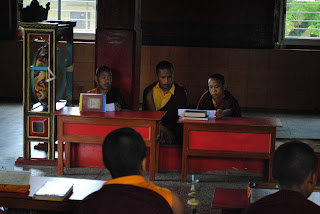Mainpat: a fantasy world in real
Mainpat is a group of 62 plateaus perched at 1100 m/3200 ft
in Sarguja District of Chhattisgarh State in India.
It is a new home of Tibetan Refugees living there
for the last five decades, along with local inhabitants.Some pictures follows to show the typical life and climate of the place..
in Sarguja District of Chhattisgarh State in India.
It is a new home of Tibetan Refugees living there
for the last five decades, along with local inhabitants.Some pictures follows to show the typical life and climate of the place..
 |
| 30 kms drive from the base of the foot hill takes us to Mainpat |
 |
| Village life in the misty mountains |
 |
| Village life in the misty mountains |
The wind went on from West to East;
All movement in the forest ceased.
But shrill and harsh across the marsh,
Its whistling voices were released.
The grasses hissed, their tassels bent,
The reeds were rattling—on it went.
O'er shaken pool under heavens cool,
Where racing clouds were torn and rent.
Now call we over the mountains cold,
'Come back unto the caverns old!'
Here at the gates the king awaits,
His hands are rich with gems and gold.
 |
| Buddhist temples and monasteries |
 |
| Buddhist temples and monasteries |
 |
| Buddhist temples and monasteries |
 |
| Buddhist temples and monasteries |
 |
| Buddhist temples and monasteries |
 |
| Buddhist temples and monasteries |
 |
| lush green fluorescent forest |
 |
| some tourist resort to stay therein |
*poem thankfully shared from: 'over the misty mountains cold' by R R Tolkein












